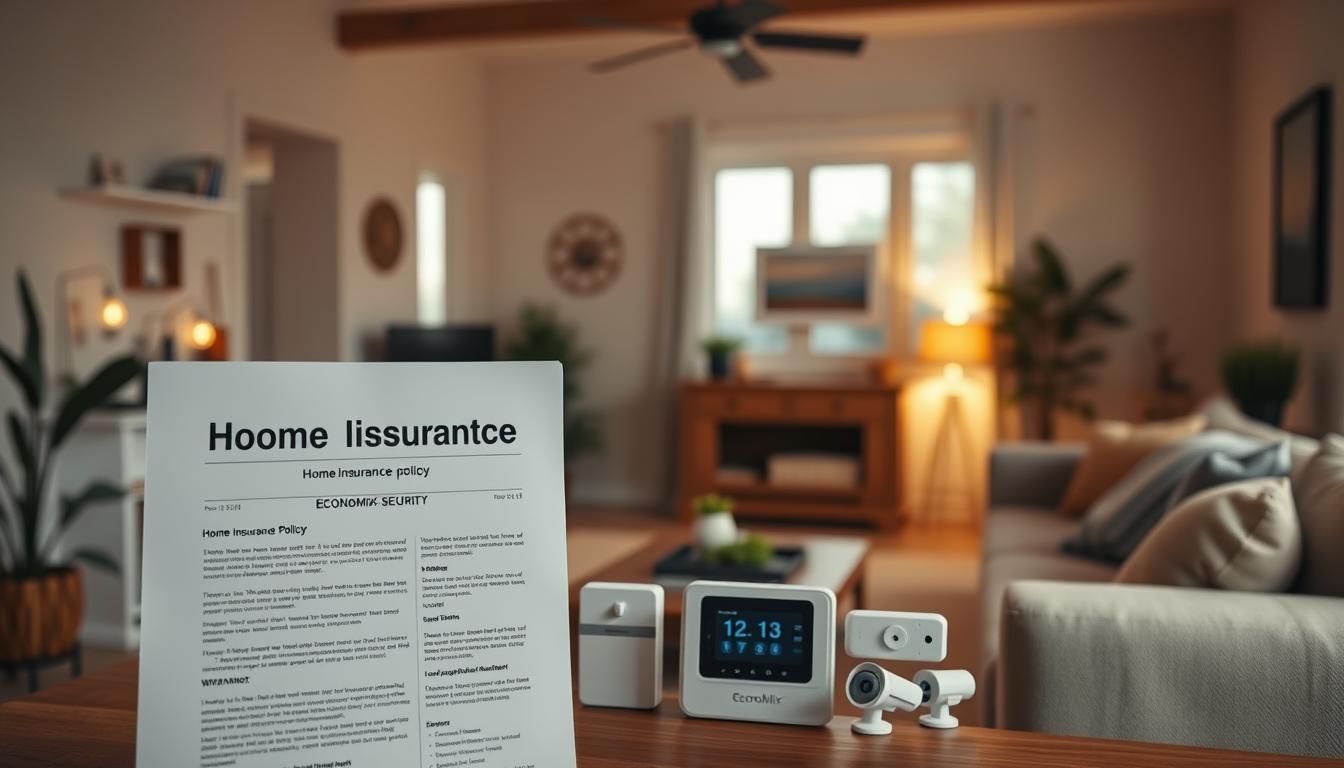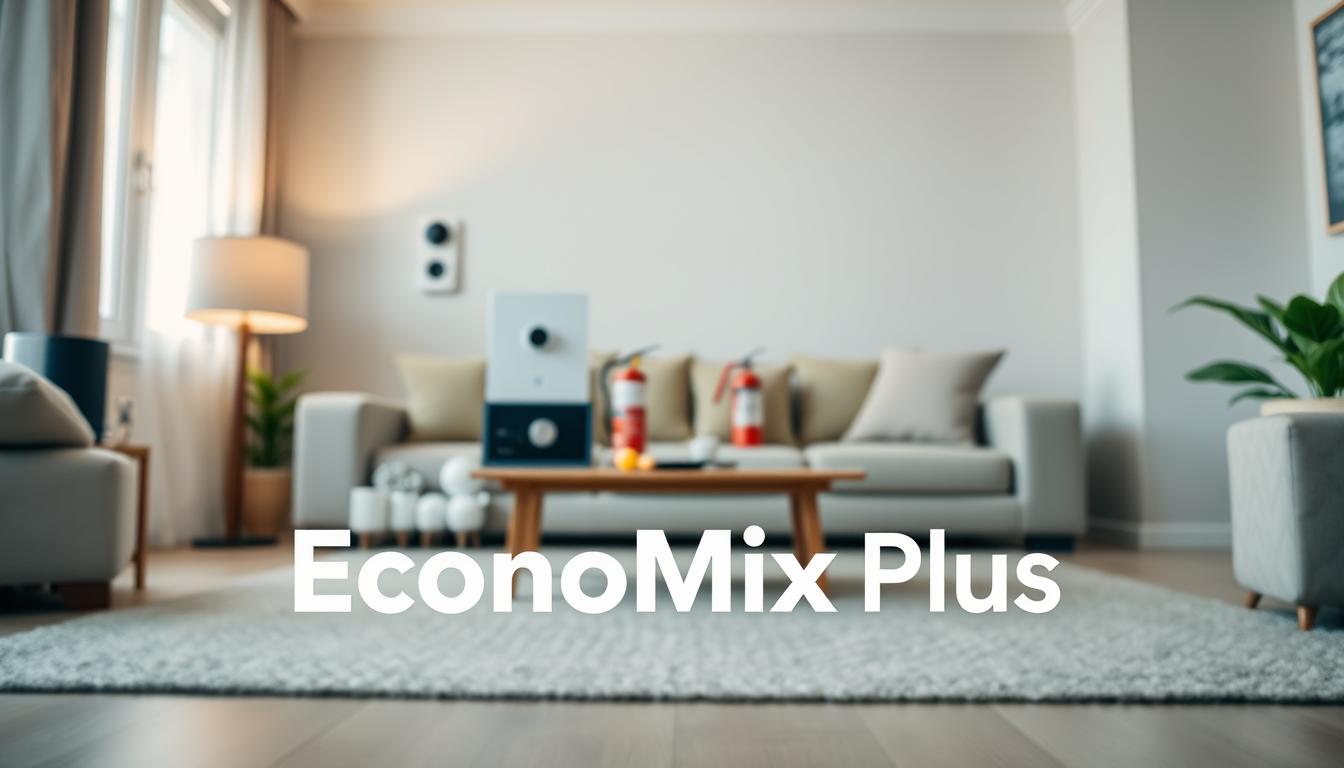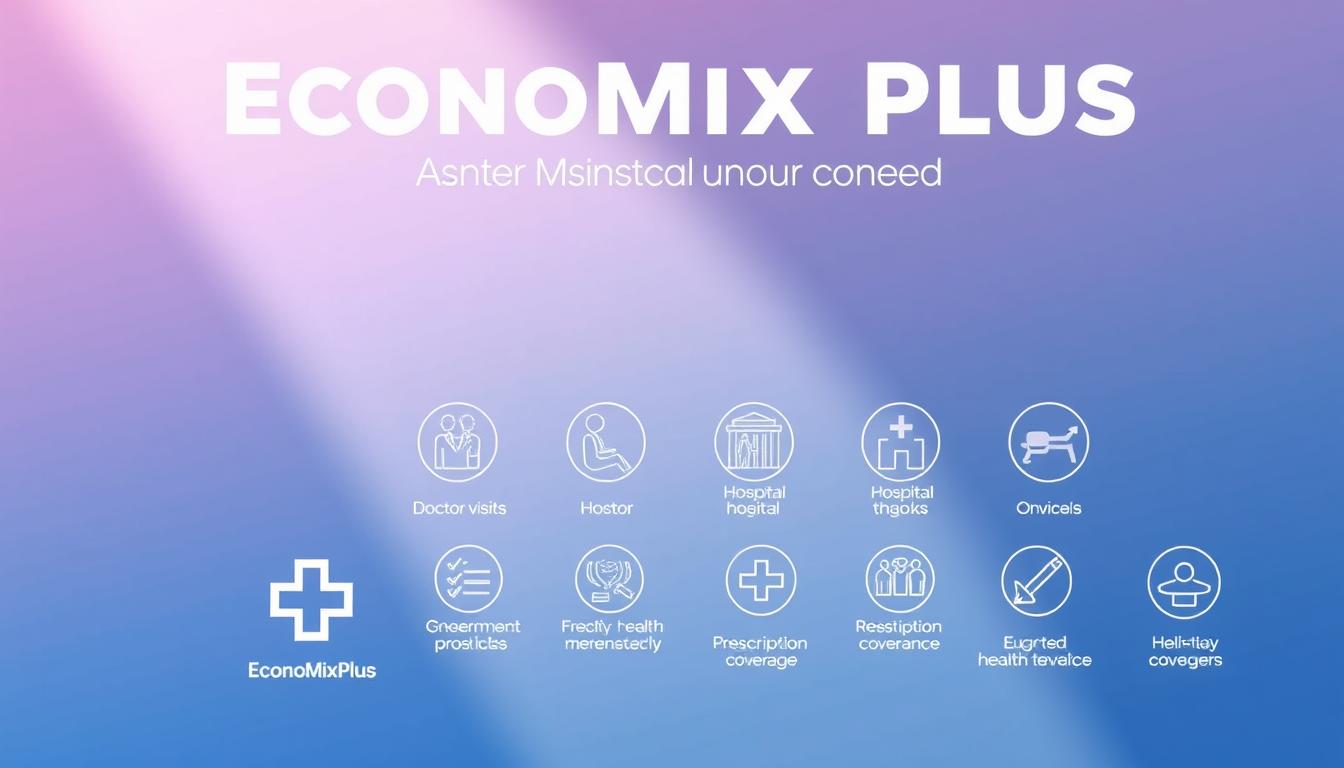As a homeowner, having the right insurance is key for home insurance protection. Most mortgage lenders need a homeowner’s insurance policy before they finalize a loan. This shows how important it is for securing your home with insurance.
Finding the right insurance for your home can seem hard. But it’s vital for protecting your investment from different risks and damages. A good homeowner’s insurance policy offers financial protection. It gives you peace of mind and security.
Key Takeaways
- Home insurance is a critical component of homeownership.
- A homeowner’s insurance policy provides financial protection against various risks.
- Choosing the right insurance coverage is essential for securing your home.
- Most mortgage lenders require a homeowner’s insurance policy.
- A well-crafted insurance policy gives you peace of mind and security.
Understanding the Fundamentals of Home Insurance
To protect your home, you need to know the basics of home insurance. Homeowner’s insurance gives financial protection for your home, its contents, and more. It covers damage from fire, smoke, water, theft, vandalism, storms, and other events listed in the policy.
What Home Insurance Actually Covers
Home insurance protects your home and personal items from risks. It covers the dwelling, other structures, personal property, loss of use, and liability. Knowing what your policy covers is key to making smart insurance choices.
For example, if a storm damages your roof, your policy might cover repairs or replacement. If your home is burglarized, your insurance can help replace stolen items or fix any damage.
Different Types of Home Insurance Policies
There are many home insurance policies, each with its own coverage and protection. The main types are:
- HO-1: Basic Form – Covers a few perils like fire, theft, and vandalism.
- HO-3: Special Form – Offers wide coverage for the dwelling and named perils for personal property.
- HO-5: Comprehensive Form – Provides full coverage for both the dwelling and personal property.
Choosing the right policy depends on your needs, home and belongings’ value, and your budget.
The Difference Between Actual Cash Value and Replacement Cost
Understanding the difference between actual cash value (ACV) and replacement cost is key. Actual Cash Value is the item’s depreciated value at loss time. Replacement Cost coverage pays for new or repaired items without depreciation.
For instance, if a five-year-old TV is stolen, an ACV policy pays its current value. A replacement cost policy pays for a new TV of similar quality.
Assessing Your Home’s Specific Insurance Needs
It’s important to know what insurance your home needs. This involves looking at several key factors. These factors help determine the right protection for your home.
Evaluating Your Property’s Value and Risk Factors
First, you need to figure out your home’s value. This includes its market value and the cost to rebuild or repair it. You should also think about risks like natural disasters, crime rates, and your home’s condition.
Here are some things to consider:
- The age and condition of your home
- The cost of rebuilding or replacing your home
- The value of your personal belongings
- Any unique features or upgrades that increase your home’s value
Identifying Your Most Valuable Assets
Your home has many valuable things that need protection. Knowing what these are is key to getting the right coverage.
Some valuable assets include:
- Jewelry and precious items
- Electronics and appliances
- Artwork and collectibles
- Important documents and family heirlooms
Considering Regional Risks in Your Area
Every area has its own risks, like floods, earthquakes, or hurricanes. Knowing these risks helps you choose the right insurance.
For example, if you live in a flood-prone area, you might need extra flood insurance. If you’re in an earthquake zone, earthquake insurance is a must.
| Region | Common Risks | Insurance Considerations |
|---|---|---|
| Coastal Areas | Floods, Hurricanes | Flood Insurance, Windstorm Coverage |
| Earthquake Zones | Earthquakes | Earthquake Insurance |
| Urban Areas | Theft, Vandalism | Personal Property Coverage, Liability Insurance |

Understanding your home’s insurance needs helps you choose the right policy. This ensures your home is well-protected.
How Can You Secure Your Home with the Right Insurance?
To protect your home and finances, picking the right insurance is key. It’s not just about buying a policy. You need to understand your insurance needs and options well.
Matching Coverage Types to Your Specific Needs
Home insurance isn’t one-size-fits-all. You must consider your home’s value and what’s inside. Special items like jewelry or art might need extra coverage.
Key Considerations for Matching Coverage:
- Think about the cost to replace your home and stuff.
- Look at risks in your area, like floods or earthquakes.
- Value any unique or expensive items.
Balancing Premiums with Adequate Protection
Finding the right balance in premiums and coverage is important. Going for the cheapest might leave you underinsured. But, too much coverage can be too pricey.
| Coverage Aspect | Low Premium | High Premium |
|---|---|---|
| Dwelling Coverage | Minimum required | Comprehensive |
| Personal Property | Basic coverage | Extended coverage |
| Liability | Standard limits | Higher limits |
Creating a Comprehensive Security Plan
A good security plan is more than insurance. It includes steps to prevent or lessen risks. Things like security systems, strong doors, and safe neighborhoods help keep your home safe.
Think about smart home tech to boost security and maybe lower insurance costs. Smart doorbells, cameras, and leak detectors can warn you early and help prove incidents.

By matching coverage to your needs, balancing costs, and planning for security, you can protect your home well. This approach safeguards your investment and gives you peace of mind.
Navigating Standard Coverage Options
It’s important to know the standard coverage options in home insurance. A basic policy covers repairs or replacement of your home. It also covers other structures, your personal belongings, and temporary living expenses for damage from fire, tornadoes, and more.

Dwelling Coverage Explained
Dwelling coverage is key in home insurance. It pays for repairs or rebuilding if your home is damaged or destroyed. This includes the main structure and attached parts like garages and decks.
Key aspects of dwelling coverage include:
- The cost to repair or rebuild your home to its original state
- Coverage for attached structures like garages and decks
- Potential coverage for detached structures, depending on your policy
Personal Property Protection
Personal property protection covers your belongings against damage or loss. This includes furniture, appliances, clothing, and other personal items.
Some key points to consider:
- Coverage limits for high-value items like jewelry or artwork
- The need for additional riders for very valuable possessions
- The importance of documenting your belongings for claims purposes
Liability Insurance Benefits
Liability insurance is a vital part of home insurance. It protects you against financial loss if someone is injured on your property. It also covers accidental damage to someone else’s property.
Benefits of liability insurance include:
- Coverage for medical expenses related to injuries on your property
- Protection against lawsuits for damages or injuries
- Coverage for damages you or your family members cause to others’ property
Exploring Additional Protection Options
Basic home insurance is a good start, but more protection is often needed. If your home is at risk from floods, earthquakes, or wildfires, extra coverage is essential. This ensures your home is fully protected.

Flood Insurance Considerations
Flood insurance is a must for homes in flood-risk areas. Regular home insurance doesn’t cover flood damage. So, you’ll need a separate policy for this.
The National Flood Insurance Program (NFIP) offers flood insurance for buildings and contents. It’s important to know your flood risk and property value. This helps you choose the right coverage.
Earthquake Coverage Necessities
Earthquake insurance is vital for homes in earthquake-prone areas. Standard policies don’t cover earthquake damage. So, you need a special policy or endorsement.
Think about your area’s earthquake risk and repair costs. Also, check your policy’s details, like deductibles and coverage limits. This ensures you’re well-protected.
Valuable Items Riders
It’s also wise to insure valuable items in your home. A valuable items rider lets you add specific items to your policy. This includes jewelry, art, or collectibles.
By scheduling these items, they’re covered for their full value. This gives you peace of mind and financial security for your most precious items.
Understanding Policy Exclusions and Limitations
It’s key to know what your home insurance policy doesn’t cover. Home insurance aims to protect your home and stuff from many risks. But, it doesn’t cover everything.
Common Exclusions in Standard Policies
Most home insurance policies don’t cover certain damages. These common exclusions include:
- Damage from sewer or septic backups
- Floods and earthquakes
- Mold and pest infestations
- Wear and tear, neglect, and poor maintenance
Knowing these exclusions helps avoid surprises when you file a claim.
Gradual Damage Issues
Damage from mold, pests, or wear and tear isn’t usually covered. This damage happens over time, not suddenly. To prevent these issues, keep your home in good shape. You might also need extra coverage.
Addressing Coverage Gaps
To fill coverage gaps, you might need extra insurance. For example, if you live where floods are common, you’ll need flood insurance. Also, if you have valuable items, you might need a rider for those.
| Exclusion Type | Description | Potential Solution |
|---|---|---|
| Flood Damage | Damage caused by flooding | Purchase flood insurance |
| Earthquake Damage | Damage caused by earthquakes | Purchase earthquake insurance |
| Mold and Pest Infestations | Damage from mold or pests | Regular maintenance, consider additional coverage |
Knowing what your policy doesn’t cover helps you get the right protection. Review your policy often and think about extra coverage. This way, you can better protect your home and belongings.

Calculating the Right Coverage Amount
To protect your home and keep your finances safe, figuring out the right insurance coverage is key. You need to look at several important factors. These help determine how much coverage you need for your home and personal items.
Home Replacement Cost Assessment
Figuring out how much it would cost to rebuild your home is a big step. This means estimating the cost to rebuild your home if it’s completely lost. You should think about construction costs, materials, and labor in your area. It’s important to know the difference between your home’s market value and its replacement cost.
Key factors to consider when assessing home replacement cost include:
- The size and complexity of your home’s design
- Local construction costs and labor rates
- The cost of materials and finishes used in your home
- Any custom or specialty features that could affect rebuilding costs
Personal Belongings Valuation
Getting the right value for your personal belongings is also key. You should make a detailed list of your items, like furniture, electronics, and clothes. For expensive items, like jewelry or art, getting a professional appraisal is a good idea.
Tips for valuing personal belongings:
- Create a detailed home inventory with receipts and photos
- Keep records of any upgrades or big purchases
- Use online tools or apps for inventory management
Liability Coverage Determination
Figuring out the right amount of liability coverage is also important. Liability coverage helps protect you if someone gets hurt on your property or if you accidentally damage someone else’s property. The amount you need depends on your assets, lifestyle, and the risks at your home.
Consider the following when determining liability coverage:
| Factor | Consideration |
|---|---|
| Assets | Think about the total value of your assets that could be at risk in a lawsuit |
| Lifestyle | Consider your lifestyle and the risks it may have, like hosting parties or having a pool |
| Potential Risks | Look at the risks at your home, like a history of claims in your area |
Comparing Insurance Providers Effectively
Finding the right insurance policy is key to protecting your home and assets without spending too much. With many insurance companies and policies out there, it’s important to look at a few key factors. This will help you make a smart choice.
Researching Company Reputations
Start by looking into the reputation of insurance companies. Check ratings from AM Best, Standard & Poor’s, and Consumer Reports. These groups judge companies on their financial health, customer happiness, and overall performance.
A high rating from AM Best means the company is financially stable. This is important for paying claims. Also, read customer reviews to see how happy others are with their policies.
“The reputation of an insurance company is built on its ability to pay claims and provide quality service.”
Evaluating Customer Service Quality
Good customer service is also key when choosing an insurance provider. You want a company that answers your questions well, explains policies clearly, and helps when needed. To check customer service, you can:
- Look at online reviews and ratings on Google and Yelp.
- Ask people you know about their experiences.
- Call the insurance company’s customer service to see how they respond.
Analyzing Claims Processing Efficiency
How well a company handles claims is also important. You want them to process claims quickly and fairly. Look for how long it takes them to settle claims and how many they approve.
| Insurance Provider | Average Claim Settlement Time | Claims Approval Rate |
|---|---|---|
| Provider A | 7 days | 95% |
| Provider B | 10 days | 90% |
| Provider C | 5 days | 98% |
By comparing these numbers, you can see which company is better at handling claims. This ensures you get the help you need when you file a claim.
Strategies for Lowering Your Premium Costs
You can cut down your home insurance costs with a few smart steps. Making smart choices about your policy can save you a lot without losing coverage. It’s all about finding the right balance.
Home Security Improvements That Reduce Rates
Boosting your home’s security can lower your insurance rates. Companies give discounts for homes with security systems, smoke detectors, and deadbolt locks. These features make your home safer and lower the risk of claims.
Here are some ways to lower your premiums through home security:
- Installing a full security system with door and window sensors.
- Switching to smart locks and security cameras.
- Making sure your home is well-lit inside and out.
Bundling Insurance Policies
Getting your home and auto insurance from the same company can save you a lot. Insurers like it when you bundle your policies. It shows loyalty and saves them money on admin costs.
| Insurance Provider | Bundling Discount |
|---|---|
| Provider A | 10% |
| Provider B | 15% |
| Provider C | 12% |
Increasing Deductibles Strategically
Raising your deductible can lower your premiums. But, it’s important to find a balance. You want a deductible that’s high enough to save money but not so high it’s unaffordable if you need to make a claim.
For example, if you’re paying $800 a year for a $500 deductible, raising it to $1,000 might save you money. But make sure you can afford the higher deductible if needed.
Key Considerations:
- Check your finances to see if a higher deductible is affordable.
- Think about the savings against the higher deductible.
- Change your deductible as your financial situation changes.
Documenting Your Home and Belongings
It’s very important to document your home and belongings for insurance. This process makes sure you’re covered well. It also makes filing claims easier if you need to.
Creating a Home Inventory
Making a detailed home inventory is the first step. You need to list all your items, their value, and descriptions. A good home inventory is key for claims.
Start by walking through your home and listing items in each room. Don’t forget furniture, appliances, clothes, and jewelry. For expensive items, add receipts, serial numbers, and appraisals.
Photographing Valuable Items
Along with your inventory, take photos of valuable items. This shows their condition and existence. Good photos are important for items hard to describe, like art or electronics.
Storing Documentation Securely
After making your inventory and photos, keep them safe. Use cloud storage or an external hard drive. Update your records often for new purchases or changes.
Documenting Repairs and Maintenance
Keep records of all repairs and maintenance. These records are useful for renewals and claims. They show you care for your property, which can help your insurance.
| Item Description | Purchase Date | Value | Serial Number |
|---|---|---|---|
| Living Room Sofa | 2020-01-01 | $1,200 | SN123456 |
| Jewelry Set | 2018-06-01 | $5,000 | N/A |
By following these steps, you’ll be ready for anything. Keep your documentation up to date.
Understanding the Claims Process
When disaster hits, knowing how to handle the claims process is key. It can make your recovery smooth or long. The claims process is a vital part of your home insurance. It helps you get back on track after unexpected damage or loss.
Steps to Take Immediately After Damage
First, make sure you’re safe and document the damage well. Take photos or videos of the damage. This visual proof is important for your claim.
- Notify your insurance provider right away to start the claims process.
- Collect any important documents, like your policy number and damage details.
- Do temporary fixes to avoid more damage, but save your receipts for later.
Filing a Claim Effectively
To file a claim well, focus on the details and know your policy. When filing, give a detailed account of the damage. Include when it happened and what was affected.
Key information to include:
- Policyholder’s name and policy number
- Date and description of the loss
- List of damaged or lost items with their value
After filing, the insurance company will review it. They might send an adjuster to check the damage. Experts say:
“The claims process is not just about filing a claim; it’s about providing a clear and detailed picture of the damage to ensure a fair and timely settlement.”
Working with Insurance Adjusters
Insurance adjusters are key in the claims process. They figure out the damage and what the insurance owes. Being ready for their visit can greatly affect your claim’s outcome.
| Tips for Working with Adjusters | Description |
|---|---|
| Be Present | Being there during the inspection lets you show the damages and give context. |
| Provide Documentation | Share your evidence, like photos and receipts, to back up your claim. |
| Understand the Process | Know what to expect during the inspection and the next steps in the claims process. |
By understanding the claims process and being ready, you can handle it better. This helps you get back to normal faster.
Reviewing and Updating Your Policy Regularly
Your home insurance needs can change over time. It’s important to review your policy regularly. As you own and maintain your home, many factors can affect your coverage.
When to Reassess Your Coverage Needs
Review your home insurance policy every year or when big changes happen. Major life events like renovations or big purchases can raise your home’s value. This might mean you need more insurance.
Also, changes in local building codes or construction costs can affect rebuilding your home. Regular checks ensure you’re not underinsured in case of a disaster.
How Home Improvements Affect Your Policy
Home improvements can change your insurance needs. Renovations that boost your home’s value or luxury might need more coverage. For example, adding high-end finishes or expanding your home can raise rebuilding costs.
Telling your insurer about home improvements is key to avoid disputes later. Keeping records of your renovations helps assess the right coverage.
Adjusting Coverage After Major Life Changes
Big life changes, like marriage or having kids, can affect your insurance. For instance, getting married might mean more possessions to insure. This could mean you need more personal property coverage.
Life events like kids moving out or a drop in income might also mean you need to adjust your policy. This ensures your coverage fits your current situation.
Regularly reviewing and updating your home insurance policy keeps it in line with your changing needs. This gives you peace of mind and financial protection against unexpected events.
Combining Insurance with Home Security Measures
It’s smart to pair the right insurance with top-notch home security. This combo shields your property from many dangers. It also might cut down your insurance costs.
Security Systems and Insurance Discounts
A strong home security system cuts down burglary and vandalism risks. This makes your home a safer bet. Many insurers give discounts to those with security systems, as these systems lower claim chances.
Key benefits of security systems include:
- Reduced risk of theft and vandalism
- Potential discounts on insurance premiums
- Enhanced peace of mind for homeowners
Smart Home Technology Benefits
Smart home tech elevates home security with features like cameras, smart locks, and sensors. These features boost security and let homeowners monitor their home live.
Some benefits of smart home technology include:
- Remote monitoring and control of home security
- Early detection of security breaches
- Integration with insurance for easier claims
Disaster Preparedness Planning
Being ready for disasters is key to home security. It means having a plan to lessen disaster impacts. Pairing disaster prep with the right insurance keeps you fully covered.
Effective disaster preparedness planning involves:
- Identifying risks in your area
- Creating an emergency plan
- Regularly checking and updating your insurance to cover risks
Avoiding Common Insurance Mistakes
It’s key to know and avoid common insurance mistakes to protect your home well. Many homeowners make big errors that can cause a lot of financial loss if not fixed.
Underinsuring Your Property
One big mistake is underinsuring your property. This happens when your coverage is less than what it costs to rebuild or replace your home and stuff. It’s important to check your property’s value often and update your coverage.
For example, if you add to your home or get new valuable things, you might need to change your coverage. This keeps your insurance up to date with your home’s value.
Misunderstanding Policy Terms
Not understanding your insurance policy can lead to surprises when you file a claim. It’s important to read and understand your policy well. Look at what’s covered, what’s not, and any special rules that might affect your coverage.
“The fine print matters. Knowing your policy’s terms can help avoid unexpected claim denials.”
For instance, some policies might not cover damage from floods or earthquakes unless you add special riders.
Neglecting to Update Coverage
As your life changes, so should your insurance. Not updating your policy can leave you without enough coverage or protection.
Big life events like getting married, having kids, or making more money can change what you need from insurance. It’s good to check and update your policy often to keep it right for your current situation.
| Common Insurance Mistakes | Consequences | Prevention Strategies |
|---|---|---|
| Underinsuring Your Property | Financial loss due to insufficient coverage | Regularly assess your property’s value and adjust coverage |
| Misunderstanding Policy Terms | Unexpected claim denials | Thoroughly read and understand policy documents |
| Neglecting to Update Coverage | Being underinsured or unprotected due to life changes | Regularly review and update your policy to reflect life changes |
Knowing these common insurance mistakes and taking steps to avoid them can help protect your home and stuff well.
Securing Peace of Mind Through Comprehensive Protection
You’ve learned about your home insurance needs. Now, you’re ready to get the right protection for your home and assets. The right insurance gives you peace of mind, knowing you’re safe from many risks.
By figuring out what your home needs, looking at standard options, and adding extra protection, you’re getting close to home insurance security. This way, you’re ready for anything, from natural disasters to unexpected claims.
Getting peace of mind isn’t just about having insurance. It’s about knowing what you have and feeling sure you can handle surprises. By following this guide, you’ll get the best home insurance protection.
FAQ
▶
▶
▶
▶
▶
▶
▶
▶
▶
▶














